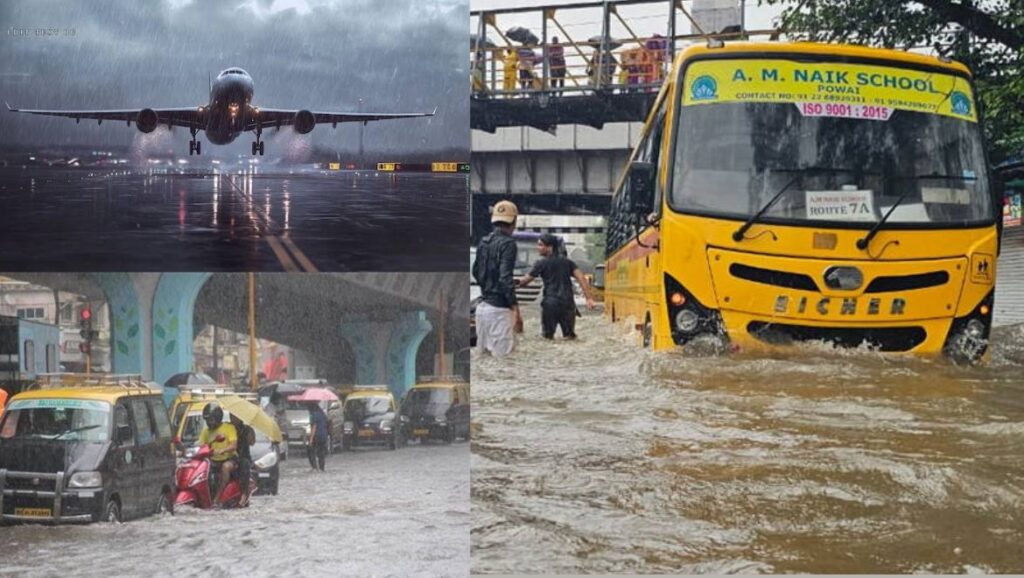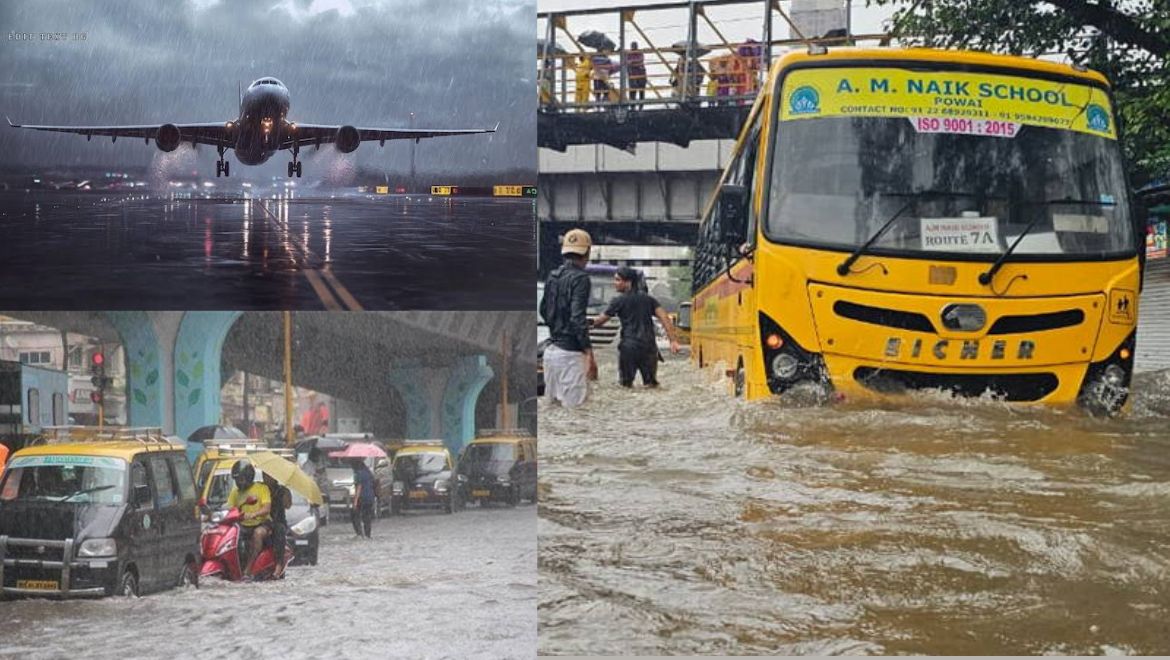Shocking Mumbai Rain 2025: What Really Happened to Flights, Roads & Schools?
The Mumbai rain has once again left India’s financial capital reeling under its unstoppable force. On August 18, 2025, torrential showers disrupted flights, drowned roads, delayed trains, and forced schools to close. For millions of Mumbaikars, it was a shocking monsoon nightmare—one that turned a normal Monday into complete mayhem.

Also Read – Major Water Logging In Mumbai
Flights Diverted as Airport Battles Zero Visibility
The Chhatrapati Shivaji Maharaj International Airport witnessed unprecedented chaos. Nine flights aborted landings and one was diverted as near-zero visibility made safe landings impossible. Airlines including IndiGo and Akasa Air quickly issued travel advisories, urging passengers to reach early and check flight status before leaving for the airport.
For frequent flyers and business travelers, the situation was stressful. Some passengers reported waiting inside flights circling above Mumbai for nearly 45 minutes before being diverted. For a city that prides itself on being connected to the world, the Mumbai rain 2025 disruption exposed just how fragile airport operations remain in extreme weather.
👉 Check IMD’s official weather alerts here.
Waterlogged Roads Bring City to a Crawl
From Andheri Subway to Chembur and Sion, streets turned into rivers within hours. The Western Express Highway, a crucial artery for Mumbai’s commuters, slowed to bumper-to-bumper traffic. Cars stalled in knee-deep water, two-wheelers skidded dangerously, and pedestrians waded through dirty, waist-high water just to get home.
Taxi drivers reported huge losses as they spent hours stuck in jams. Food and parcel deliveries were delayed, leaving office workers and families frustrated. The truth is, Mumbai’s drainage system is built for just 25 mm/hour, while modern rainfall events often cross 60 mm in a single hour. The shocking gap between rainfall and drainage capacity means the city continues to drown every year.
👉 Related Read: KTM Duke 160 vs Yamaha MT-15 V2 – Which Bike Wins in 2025?
Local Trains Delay & Schools Shut Down
Mumbai’s lifeline—the suburban railways—also faced delays of 15–20 minutes on Central and Harbour lines. For office-goers, this meant late arrivals, overcrowded platforms, and anxiety about returning home in worsening conditions.
Parents were relieved when the BMC declared schools and colleges shut, but the sudden closure also caused confusion. Students who managed to reach schools early in the morning were sent back mid-session. For working families, balancing office schedules with kids stuck at home became a challenge.
👉 Follow BMC’s real-time Twitter updates here.
IMD Issues Red Alert
The India Meteorological Department (IMD) placed Mumbai, Thane, and Palghar under a Red Alert, predicting extremely heavy rainfall in isolated areas. For August 19, an Orange Alert was issued, keeping the city on edge.
Rainfall data was shocking—Chembur recorded 65 mm in just one hour. With such intense bursts becoming common, experts say short-duration heavy rainfall is now a bigger threat than long, steady showers.
History Keeps Repeating
Sadly, this is not a new story. Mumbai has been here before:
-
In 2005, the city saw a record 944 mm rainfall in 24 hours, flooding homes, hospitals, and railway stations, killing hundreds.
-
In 2017, another 468 mm in 12 hours once again brought life to a standstill, grounding flights and shutting down local trains.
Despite these disasters, Mumbai rain remains an unsolved urban challenge. The city learns temporary lessons but fails to implement long-term structural fixes.
👉 Related Read: NTorq 150 First Teaser – New Scooter Launch in India
Impact on Daily Life & Economy
The downpour didn’t just inconvenience travelers—it also impacted businesses. Shops in low-lying areas reported water seeping into storerooms, damaging stock. Office attendance dropped, and many companies switched to remote work for the day. Street vendors, who rely on daily earnings, suffered the most as customers stayed indoors.
Health experts also warned of rising risks of waterborne diseases like leptospirosis, dengue, and cholera in the aftermath of flooding. Doctors advised citizens to avoid wading through stagnant water whenever possible.
What Needs to Change Now
Experts believe Mumbai must urgently rethink its infrastructure. Some critical steps include:
-
Upgrading drainage capacity from 25 mm/hr to at least 75 mm/hr.
-
Installing high-capacity pumps in hotspots like Sion, Dadar, and Kurla.
-
Elevated roads and covered train tracks in flood-prone areas.
-
AI-powered weather warning systems for smarter civic response.
On the positive side, civic bodies, NGOs, and citizen groups are working together more than ever. Rain shelters, rescue boats, and social media awareness campaigns helped many stranded commuters this year.
Final Takeaway
The shocking Mumbai rain of 2025 once again exposed the city’s vulnerabilities—flights diverted, schools closed, trains delayed, and roads waterlogged. Yet, the spirit of Mumbai remained unbroken. Residents helped one another, shared rides, and showed resilience in the face of adversity.
Until deep structural reforms take place, every monsoon will remain both a negative test of infrastructure and a positive showcase of Mumbaikar courage and unity.

4 thoughts on “Shocking Mumbai Rain 2025: What Really Happened to Flights, Roads & Schools?”